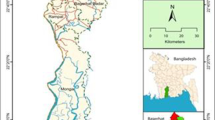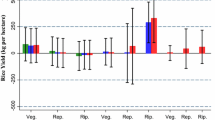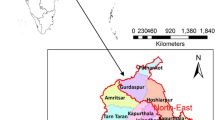Abstract
Because of evident climatic variations and significant contribution to national food production, Bangladesh is a climate extreme hotspot region of examination for climatic consequences for rice (Oryza Sativa) crop production. This study intends to explore the variability of climatic variables (e.g., variations in mean temperature, rainfall, relative humidity, and sunshine duration) with rice yields (e.g., Aus, Aman, and Boro rice varieties) in northwest Bangladesh. The modified Mann–Kendall test, Theil–Sen slope estimator, and multiple linear regression (MLR) modeling were used to estimate the association among these factors. Heteroskedasticity and autocorrelation constant standard error (HAC) and feasible generalized least square (FGLS) technique were adopted to measure the climate-rice crop nexus using the regional level dataset for 1976–2015. Furthermore, the spatiotemporal variation of rice yield trends with climatic variables was mapped and assessed by the coefficient of variation. The results show that observed temperature and humidity trends were beneficial for Aus and Aman yields but not Boro yields. In contrast, observed rainfall and sunshine trends were negative for all three rice seasons. The outcomes of the MLR model explained 67%, 92%, and 83% of the variability in Aus, Aman, and Boro rice yields in the study region. The model outcomes showed that humidity and rainfall have negatively affected Aus and Aman rice crops, while temperature and rainfall positively influence Boro rice yield. Regarding the climate change issues and safeguarding food safety at the regional level, the concerned authorities should provide substantial attention to improving heat and drought-tolerance high-yielding varieties against climate effects on Aus and Aman rice varieties.





Similar content being viewed by others
Data availability
Data are available upon request on the corresponding author
Code availability
Not applicable
References
Akhter S, Eibek KU, Islam S, Islam ARMT, Shen S, Chu R (2019) Predicting spatiotemporal changes of channel morphology in the reach of Teesta River,. Quat Int 513:80–94. https://doi.org/10.1016/j.quaint.2019.01.022
Ali MH (2018) Drought Screening and Supplemental Irrigation Management for some Rice Cultivars in Drought Prone Area of Bangladesh. Int J Appl Sci 1(2):107. https://doi.org/10.30560/ijas.v1n2p107
Amin MR, Zhang J, Yang M (2015) Effects of climate change on the yield and cropping area of major food crops: a case of Bangladesh. Sustain Sci 7(1):898–915
Ara I, Lewis M, Ostendorf B (2016) Spatio-temporal analysis of the impact of climate, cropping intensity and means of irrigation: an assessment on rice yield determinants in Bangladesh. Agric Food Secur 5(1):1–11
Arunrat N, Pumijumnong N, Sereenonchai S, Chareonwong U, Wang C (2020) Assessment of climate change impact on rice yield and water footprint of large-scale and individual farming in Thailand. Sci Total Environ. 726:137864
Basak JK, Ali MA, Islam MN, Rashid MA (2010) Assessment of the effect of climate change on Boro rice production in Bangladesh using DSSAT model. J Civ Eng 38:95–108
BBS (2017) Agricultural Statistical Yearbook of Bangladesh, GoB, Dhaka, Bangladesh
Bhandari K, Nayyar H (2014) Low Temperature Stress in Plants: An Overview of Roles of Cryoprotectants in Defense. Available online: http://link.springer.com/chapter/10.1007/978-1-4614-8591-9_9 http://link.springer.com/chapter/10.1007/978-1-4614-8591-9_9. Accessed 21 Dec 2014
Chen C, McCarl BA, Schimmelpfennig DE (2004) Yield variability as influenced by climate: a statistical investigation. Clim Change 66:239–261
Dickey DA, Fuller WA (1979) Distribution of the estimators for autoregressive time series with a unit root. J Am Stat Soc 75:427–431
Dina RA, Islam ARMT (2020) Assessment of drought disaster risk in Boro rice cultivated areas of northwestern Bangladesh. Euro J Geoscien 2(1):19–29
Ghose B, Islam ARMT, Salam R, Shahid S, Kamruzzaman M, Das S, Elbeltagi A, Salam MA, Mallick J (2021a) Rice yield responses in Bangladesh to large-scale atmospheric oscillation using multifactorial model. Theor Appl Climatol. https://doi.org/10.1007/s00704-021-03725-7
Ghose B, Islam ARMT, Kamruzzaman M, Moniruzzaman M, Hu Z (2021b) Climate-induced rice yield anomalies linked to large-scale atmospheric circulation in Bangladesh using multi-statistical modeling. Theor Appl Climatol 144:1077–1099. https://doi.org/10.1007/s00704-021-03584-2
Huang J, Islam ARMT, Zhang F, Hu Z (2017) Spatiotemporal analysis the precipitation extremes affecting rice yield in Jiangsu province, southeast China. Int J Biometeorol 61(6):1–10
IPCC (2013) Climate change 2013: the physical science basis. In: Stocker TF et al. (eds) Contribution of Working Group I to the Fifth Assessment Report of the Intergovernmental Panel on Climate Change. Cambridge University Press, Cambridge
Islam ARMT, Karim MR, Mondol MAH (2021) Appraising trends and forecasting of hydroclimatic variables in the north and northeast regions of Bangladesh. Theor Appl Climatol 143(1–2):33–50. https://doi.org/10.1007/s00704-020-03411-0
Islam ARMT, Rahman MS, Khatun R, Hu Z (2020a) Spatiotemporal trends in the frequency of daily rainfall in Bangladesh during 1975–2017. Theor Appl Climat 141:869–887
Islam ARMT, Shen S, Hu Z, Rahman MA (2017) Drought Hazard Evaluation in Boro Paddy Cultivated Areas of Western Bangladesh at Current and Future Climate Change Conditions. Adv Meteorol 3514381:12
Islam ARMT, Shen S, Yang S, Hu Z, Rahman MA (2020b) Spatiotemporal rice yield variations and potential agro-adaptation strategies in Bangladesh: A biophysical modeling approach. Sustain Prod Consumpt 24:121–138. https://doi.org/10.1016/j.spc.2020.07.005
Islam ARMT, Shen S, Yang SB, Hu Z, Chu R (2019) Assessing recent impacts of climate change on design water requirement of Boro rice season in Bangladesh. Theor Appl Climatol 138:97–113
Jhajharia D, Dinpashoh Y, Kahya E, Choudhary RR, Singh VP (2014) Trends in temperature over Godavari river watershed in southern peninsular India. Inter J Climatol 34:1369–1384
Jhajharia D, Singh VP (2011) Trends in temperature, diurnal temperature range and sunshine duration in Northeast India. Int J Climatol 31(9):1353–1367
Jerin JN, Islam HM, Islam ARMT, Shahid S, Hu Z, Badhon MA, Chu R, Elbeltagi A (2021) Spatiotemporal trends in reference evapotranspiration and its driving factors in Bangladesh. Theor Appl Climatol 144:793–808. https://doi.org/10.1007/s00704-021-03566-4
Kamruzzaman M, Hwang S, Cho J, Jang MW, Jeong H (2019) Evaluating the spatiotemporal characteristics of agricultural drought in Bangladesh using Effective Drought Index. Water 11:2437
Kamruzzaman M, Shahid S, Islam ARMT et al. (2021) Comparison of CMIP6 and CMIP5 model performance in simulating historical precipitation and temperature in Bangladesh: a preliminary study. Theor Appl Climatol. Springer, SCOPUS/ISI Index, IF: 3.17.https://doi.org/10.1007/s00704-021-03691-0
Kendall MG (1975) Rank correlation methods. Griffin and Co, London
Kukal MS, Irmak S (2018) Climate-Driven Crop Yield and Yield Variability and Climate Change Impacts on the U.S. Great Plains Agricultural Production. Sci Rep 8:3450
Li M, Chu R, Shen S, Islam ARMT (2018) Dynamic analysis of pan evaporation variations in the Huai River Basin, a climate transition zone in eastern China. Sci Total Environ 625:496–509
Lobell DB, Bänziger M, Magorokosho C, Vivek B (2011) Nonlinear heat effects on African maize as evidenced by historical yield trials. Nature Clim Change 1:42–45
Lobell DB, Burke MB, Tebaldi C, Mastrandrea MD, Falcon WP, Naylor RL (2008) Prioritizing climate change adaptation needs for food security in 2030. Science 319(5863):607–610
Mamun AA, Roy S, Islam ARMT, Alam GMM, Alam E, Pal SC, Sattar MA, Mallick J (2021) Smallholder Farmers’ Perceived Climate-Related Risk, Impact, and Their Choices of Sustainable Adaptation Strategies. Sustainability 13:11922. https://doi.org/10.3390/su132111922
Mottaleb KA, Gumma MK, Mishra AK, Mohanty S (2015) Quantifying production losses due to drought and submergence of rainfed rice at the household level using remotely sensed MODIS data. Agric Syst 137:227–235
Mann HB (1945) Nonparametric tests against trend. Econometrica 13:245–259
McCarl BA, Villavicencio X, Wu X (2008) Climate change and future analysis: Is stationary dying? Am J Agr Econ 90:1241–1247
Mishra AK, Mottaleb KA, Ar Khanal, Mohanty S (2015) Abiotic stress and its impact on production efficiency: The case of rice farming in Bangladesh. Agric Ecosyst Environ 199:146–153
Mottaleb KA, Rejesus RM, Mirty MVR, Mohanty S, Li T (2017) Benefits of the development and dissemination of climate-smart rice: ex ante impact assessment of drought-tolerant rice in South Asia. Mitig Adapt Strateg Glob Change 22:879–901
Peng S (2004) Rice yields decline with higher night temperature from global warming. Proc Natl Acad Sci USA 101:9971–9975
Praveen B, Talukdar S, Shahfahad, Mahato S, Mondal J, Sharma P, Islam ARMT, Rahman A (2020) Analyzing trend and forecasting of rainfall changes in India using non-parametrical and machine learning approaches. Sci Rep. 10:10342
Radziejewski M, Zbigniew WK (2004) Detectability of changes in hydrological records. Hydrol Sci J 49:39–51
Rahman MA, Yunsheng L, Sultana N (2017) Analysis and prediction of rainfall trends over Bangladesh using Mann-Kendall, Spearman’s rho tests and ARIMA model. Meteorol Atmos Phys 129:409–424
Rahman MS, Islam ARMT (2019) Are precipitation concentration and intensity changing in Bangladesh overtimes? Analysis of the possible causes of changes in precipitation systems. Sci Total Environ 690:370–387
Ray DK, Ramankutty N, Mueller ND, West PC, Foley JA (2012) Recent patterns of crop yield growth and stagnation. Nat Commun 3:129. https://doi.org/10.1038/ncomms2296
Rimi RH, Rahman SH, Karmakar S, Hussain SG (2009) Trend analysis of climate change and investigation on its probable impacts on rice production at Sathkhira,. Pakistan J Meteorol. 6:37–50
Ruane AC, Major DC, Yu WH (2013) Multi-factor Impact Analysis of Agricultural Production in Bangladesh with Climate Change. Glob Environ Change 23(1):338–350
Salam R, Islam ARMT, Islam S (2020) Spatiotemporal distribution and prediction of groundwater level linked to ENSO teleconnection indices in the northwestern region of Bangladesh. Environ Dev Sustain 22:4509–4535
Salam R, Islam ARMT (2020) Potential of RT, Bagging and RS ensemble learning algorithms for reference evapotranspiration prediction using climatic data-limited humid region in Bangladesh. J Hydrol 590:125241. https://doi.org/10.1016/j.jhydrol.2020.125241
Sarker MAR, Alam K, Gow J (2014) Assessing the Effects of Climate Change on Rice Yields: An Econometric Investigation using Bangladeshi Panel Data. Econ Anal Policy 44(4):405–416
Sarker MAR, Alam K, Gow J (2019) Performance of rain-fed Aman rice yield in Bangladesh in the presence of climate change. Renew Agric Food Syst 34(4):304–313
Sen PK (1968) Estimates of the regression coefficient based on Kendall’s tau. J Am Stat Assoc 63:1379–1389
Shahid S, Wang X-J, Harun SB, Shamsudin SB, Ismail T, Minhans A (2016) Climate variability and changes in the major cities of Bangladesh: observations, possible impacts and adaptation. Reg Environ Change 16(2):459–471
Sombroek WG, Gommes R (2014) The Climate Change Agriculture Conundrum: Global Climate Change and Agricultural Production. Direct and Indirect Effects. In FAO Corporate Document Repository; Available online: http://www.fao.orgldocrep/w5183E/w5183e03.htm#1%20the%20climate. Accessed 10 May 2014
Uddin MJ, Hu J, Islam ARMT, Eibek KU, Zahan MN (2020) A comprehensive statistical assessment of drought indices to monitor drought status in Bangladesh. Arab J Geoscien 13:323
Yu WH, Alam M, Hassan A, Khan AS, Ruane AC, Rosenzweig C, Major DC, Thurlow J (2010) Climate Change Risk and Food Security in Bangladesh. Earth Scan, London
Zannat F, Islam ARMT, Rahman MA (2019) Spatiotemporal variability of rainfall linked to ground water level under changing climate in northwestern region,. Euro J Geoscien 1(1):35–58
Zinat MRM, Salam R, Badhan MA, Islam ARMT (2020) Appraising drought hazard during Boro rice growing period in western Bangladesh. Inter J Biometeorol. https://doi.org/10.1007/s00484-020-01949-2
Acknowledgement
The authors would like to express their gratefulness to the Bangladesh Meteorological Department (BMD) and the Bangladesh Bureau of Statistics (BBS) for sharing data for this research. We would also like to extend our thanks to the Department of Disaster Management, Begum Rokeya University, Rangpur, for providing valuable support during this study.
Author information
Authors and Affiliations
Contributions
A.R.M.T.I., J.M., and M.B.R. designed, planned, conceptualized, drafted the original manuscript; M.H. and I.A.N were involved in statistical analysis and interpretation; M.B.R., A.E., and J.M. contributed to instrumental setup, data analysis, and validation; K.T., A.E., I.A.N., and M.H. contributed to editing the manuscript, literature review, and proofreading; J. M., K.T., S.C.P., M.M.R., and A.R.M. T.I. were involved in software, mapping, and proofreading during the manuscript drafting stage.
Corresponding authors
Ethics declarations
Ethical approval
Not applicable
Consent to Participate
Not applicable
Consent to Publish
Not applicable
Conflict of interest
There is no conflict of interest to publish this work.
Additional information
Publisher's Note
Springer Nature remains neutral with regard to jurisdictional claims in published maps and institutional affiliations.
Supplementary Information
Below is the link to the electronic supplementary material.
Rights and permissions
About this article
Cite this article
Islam, A.R.M.T., Nabila, I.A., Hasanuzzaman, M. et al. Variability of climate-induced rice yields in northwest Bangladesh using multiple statistical modeling. Theor Appl Climatol 147, 1263–1276 (2022). https://doi.org/10.1007/s00704-021-03909-1
Received:
Accepted:
Published:
Issue Date:
DOI: https://doi.org/10.1007/s00704-021-03909-1




